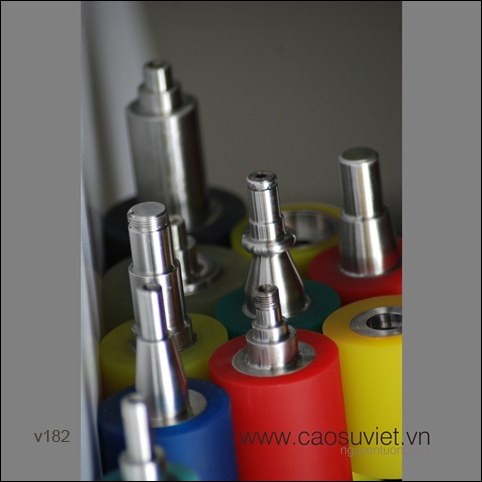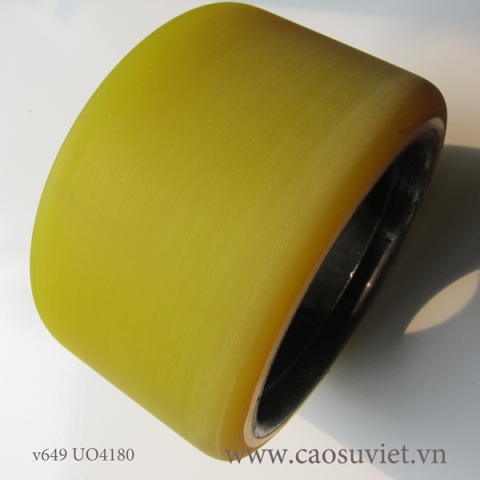| Even after the metal parts are
coated with adhesive, care must be taken to ensure that the surface of the
adhesive film does not become contaminated prior to moulding. |
Ngay sau khi chi tiết kim loại
được bao phủ chất kết dính, phải chú ý để đảm bảo rằng bề mặt của lớp màng kết
dính không bị nhiễm bẩn trước khi đúc khuôn. |
| Any material (dirt, oil, etc.)
which can get in between the adhesive and the rubber will prevent the formation
of a robust chemical bond and failure will be likely to result. |
Bất cứ chất nào (chất bẩn, dầu
…) nằm giữa chất kết dính và cao su cũng ngăn cản sự hình thành liên kết hóa học
bền và sự hư hỏng gần như xảy ra. |
| Operators who handle coated
parts should wear clean cotton gloves to prevent oils from their hands from
contaminating the adhesive. |
Những công nhân nên mang găng
tay cotton sạch khi thao tác với các chi tiết kim loại được bao phủ để tránh dầu
mỡ từ tay họ làm bẩn chất kết dính. |
Coated parts should not be
stored in areas where they can be exposed to mould releases (either splashed or
airborne droplets), dust, and moisture. |
Các chi tiết được bao phủ
không nên được tồn trữ ở những nơi mà chúng có thể tiếp xúc với chất thoát khuôn
( những giọt bị văng hoặc bay trong không khí), bụi và ẩm. |
| If coated parts are to be
stored for any extended period of time, the container should be covered with
either cardboard or untreated Kraft paper. |
Nếu các chi tiết bao phủ được
tồn trữ trong một khoảng thời gian kéo dài, thùng chứa nên được phủ bằng giấy
cac-tông hoặc giấy Kraft chưa xử lý. |
| Coated parts should also be
kept in areas where they will not be exposed to sunlight or UV radiation for
extended periods of time. |
Các chi tiết được bao phủ nên
được giữ trong những khu vực mà chúng không tiếp xúc trực tiếp với ánh sáng mặt
trời hoặc tia UV trong một khoảng thời gian kéo dài. |
| The moulding step is arguably
the most important step in the process of making rubber to metal bonded
parts. |
Bước đúc khuôn được cho là
bước quan trọng nhất trong quá trình kết dính cao su với các chi tiết kim
loại. |
| It is during this step, with
heat and pressure applied for a prescribed amount of time, that the rubber is
vulcanised and the actual bond between the rubber and the adhesive-coated part
is formed. |
Vì trong bước này, nhiệt và áp
suất được áp vào trong một khoảng thời gian quy định, cao su được lưu hóa và sự
liên kết thực sự giữa cao su và chi tiết kim loại được phủ chất kết dính hình
thành. |
| Each step of the moulding
process must be carefully controlled to maintain consistently good quality in
the bonded parts. |
Mỗi bước của quá trình đúc
khuôn phải được kiểm soát cẩn thận để duy trì chất lượng của các chi tiết kết
dính tốt.
|
| Three of the most important
factors are moulding pressure, moulding temperature, and mould
design. |
Ba trong các yếu tố quan trọng
nhất là áp suất đúc, nhiệt độ đúc và hình dạng khuôn. |
| For the best adhesion, it is
important to maintain maximum mould pressure while the rubber is at minimum
viscosity. |
Để đạt được tính kết dính tốt
nhất, quan trọng là phải duy trì áp suất đúc cao nhất trong khi cao su có độ
nhớt thấp nhất. |
| This ensures the best wetting
of the rubber over the adhesive surface. |
Điều này đảm bảo tính thấm ướt
tốt nhất của cao su lên bề mặt chất kết dính. |
| Adequate pressure must be
maintained throughout the rubber cure cycle. |
Áp suất thích hợp phải được
duy trì trong suốt quá trình kết mạng cao su. |
| If the pressure is
insufficient, the rubber may become porous during the cure and the bond to the
adhesive will be poor. |
Nếu áp suất không đủ, cao su
có thể trở nên xốp trong quá trình kết mạng và liên kết với chất kết dính sẽ
kém. |
| The temperature throughout the
mould must be maintained at a consistent level. |
Nhiệt độ trên khuôn phải được
duy trì ở một mức cố định. |
| Low temperature zones in the
mould can cause undercure of the rubber and this will lead to poor
adhesion. |
Các vùng nhiệt độ thấp trên
khuôn sẽ làm cao su chưa kết mạng hoàn toàn và điều này sẽ dẫn đến tính kết dính
kém. |
| High temperature areas in the
mould can cause overcure or reversion (crosslink degradation) of the rubber and
possible pre-cure of the adhesive before rubber can come into intimate contact
with it. |
Các vùng nhiệt độ cao trong
khuôn có thể gây nên quá lưu hoặc suy giảm cơ lý (reversion) (giảm cấp liên kết
ngang) của cao su và có thể gây nên quá trình lưu hóa sớm của chất kết dính
trước khi cao su có thể đến và tiếp xúc với nó. |
| When designing moulds, loading
of coated metals and removal of bonded parts should be made as easy as
possible. |
Khi thiết kế khuôn, việc đặt
vào và lấy các chi tiết kim loại ra nên được thực hiện dễ nhất có
thể. |
| The time required to load the
mould with adhesive coated metals should be kept to a minimum. |
Thời gian cần thiết để đặt các
chi tiết kim loại được phủ chất kết dính vào trong khuôn nên giữ ngắn
nhất. |
| The longer the coated metals
sit in the hot mould without being exposed to rubber, the greater the chance
that premature curing of the adhesive will take place, with a subsequent loss of
adhesion. |
Kim loại được bao phủ nằm
trong khuôn nóng mà không tiếp xúc với cao su càng lâu thì khả năng xảy ra quá
trình lưu hóa sớm chất kết dính càng cao, dẫn đến sự giảm tính kết dính sau
này. |
| Effort should be made when
designing both the part and the mould to place areas of high stress
concentration as far away from the rubber/metal interface as
possible. |
Khi thiết kế chi tiết và
khuôn, cố gắng đặt những khu vực tập trung ứng suất cao cách bề mặt phân cách
cao su/ kim loại càng xa càng tốt. |
| Mould parting lines should be
avoided in critical bond areas. |
Tránh thiết kế những đường
phân khuôn nằm trong những khu vực liên kết then chốt. |
| Sprues and gates into the
cavity should be placed if possible in such a manner that the flow of rubber
does not cause sweeping of the adhesive from the metal surface. |
Các rãnh và cổng vào lỗ khuôn
nếu có thể nên được đặt sao cho dòng chảy của cao su không quét chất kết dính ra
khỏi bề mặt kim loại. |
| Moulds can create problems for
the bonding process if they are either too tight or too loose. |
Khuôn cũng gây ra các vấn đề
trong quá trình kết dính nếu chúng quá chặt hoặc quá lỏng. |
| If they are too tight,
volatile gases cannot escape, but if they are too loose, the rubber compound can
continue to seep out under pressure before and during the vulcanisation
stage. |
Nếu chúng quá chặt thì các khí
dễ bay hơi không thể thoát ra ngoài, nhưng nếu chúng quá lỏng thì hỗn hợp cao su
có thể tiếp tục xì ra ngoài do áp suất trước và trong quá trình lưu
hóa. |
| This continued seepage can
cause the adhesive to be swept from the metal surface, reducing the integrity of
the bond. |
Sự xì ra liên tục này có thể
làm cho chất kết dính bị quét ra khỏi bề mặt kim loại, làm giảm tính toàn vẹn
của liên kết. |
| It can also cause a loss of
pressure inside the cavity, and adequate pressure is one of the factors
necessary for good bonding.. |
Nó cũng là nguyên nhân làm
giảm áp suất bên trong khuôn, mà áp suất đủ là một trong những yếu tố cần thiết
để kết dính tốt. |
| Moulds should be vented if
possible to allow for escape of volatile components from both the adhesive film
and from the rubber during the moulding process. |
Nếu có thể, khuôn cũng nên
được thông hơi để cho phép các thành phần dễ bay hơi từ lớp màng kết dính và cao
su thoát ra ngoài trong quá trình đúc khuôn. |
| If the volatile components
from the adhesive are not allowed to escape, they may react with the rubber
being introduced into the mould cavity and cause pre-cure of the rubber before
it has a chance to fill the cavity. |
Nếu các thành phần dễ bay hơi
trong chất kết dính không thoát ra ngoài được, chúng có thể phản ứng với cao su
trong khuôn và gây lưu hóa sớm cao su trước khi nó có thể điền đầy
khuôn. |
| When this happens, bonded
parts have small ‘knit lines’ or ‘splits’ formed in the body of the
rubber. |
Khi điều này xảy ra, các chi
tiết kết dính có các vết nứt nhỏ đan xen nhau hoặc các vết tách bóc bên trong
cao su. |
| These knit lines often
dramatically shorten the useful service life of a bonded part by developing into
premature fatigue cracks during service. |
Những vết nứt này làm giảm
thời gian sử dụng của chi tiết kết dính rất nhiều do sự phát triển thành các vết
nứt mỏi sớm trong thực tế sử dụng. |
| If volatile compounds from the
rapidly heating rubber are not vented, they may contaminate the adhesive
surface, thus reducing the quality of the bond. |
Nếu các chất dễ bay hơi từ quá
trình gia nhiệt nhanh cao su không thoát ra ngoài được thì chúng có thể làm
nhiễm bẩn bề mặt chất kết dính và vì thế làm giảm chất lượng của liên
kết. |


Nhận xét
Đăng nhận xét